The most modern city in Italy, Milan is considered one of the world’s leading cities for fashion and design, full of boutiques and designer flagship stores like Prada and Gucci.
This northern city is also Italy’s financial center, the capital of Lombardy, and one of Italy’s great cultural hubs, home to a wide variety of must-see Milan landmarks.
Despite being mostly modern, Milan boasts quite a few amazing historical landmarks, beautiful churches, and cool museums.
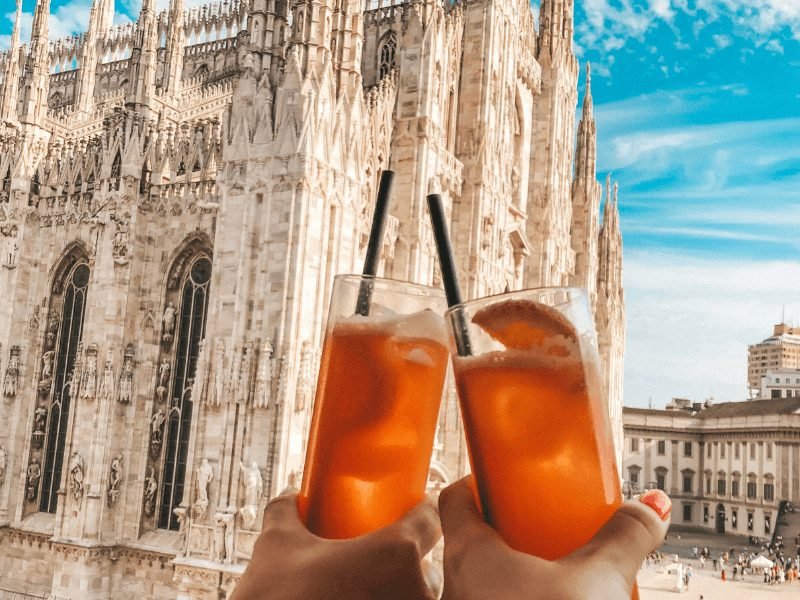
From the symbol of the city, the Milan Duomo, to the lesser-known museums, churches, and modern landmarks, there is much to discover when you’re exploring all the best landmarks Milan.
Whether you are planning your first trip (for one day, a weekend, or more!) or have already visited the city, there’s always something new to discover.
Here are the landmarks and attractions you should not miss in Milan!
Milan Attraction Map
25 Can’t-Miss Milan Landmarks
Duomo di Milano (Milan Cathedral)
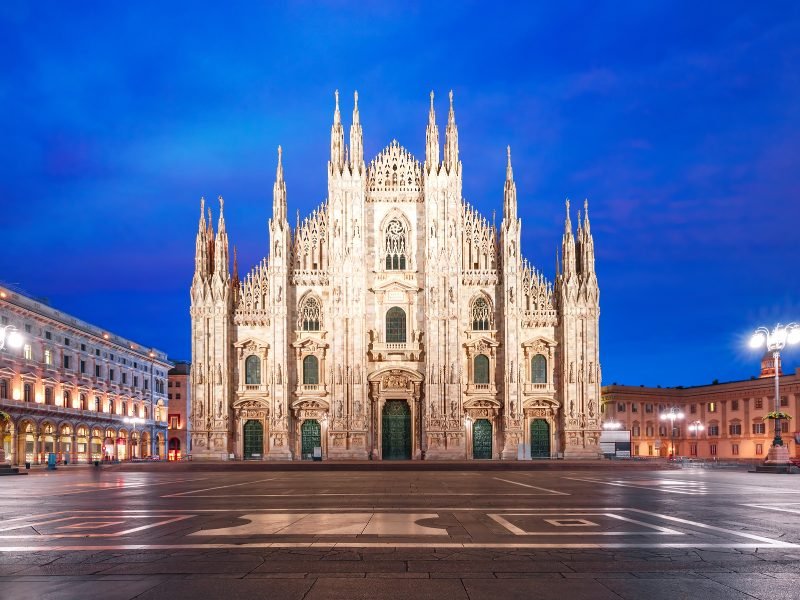
The symbol of Milan, the Duomo di Milano is an imposing Gothic church in the heart of the city.
Not only is the Duomo a significant landmark in Milan, but it is also the largest Gothic cathedral in the world!
While the cathedral is beautiful from the outside, with its beautiful spires and dramatic facade, the most epic views are on the inside and its rooftop.
To visit the Duomo, you can choose between different entry tickets, each giving you access to different areas.
It can be a little hard to puzzle out what’s what, so we’ve written a full guide to the Duomo and its terraces here.
The most complete visit includes the cathedral, the archaeological area under the cathedral, the rooftops (which you can reach by elevator or by stairs), the Duomo Museum, the Church of San Gottardo, and any ongoing exhibitions.
Book your complete entry ticket and skip the line here! You can also opt to take a guided tour of the Cathedral and Terraces.
Castello Sforzesco
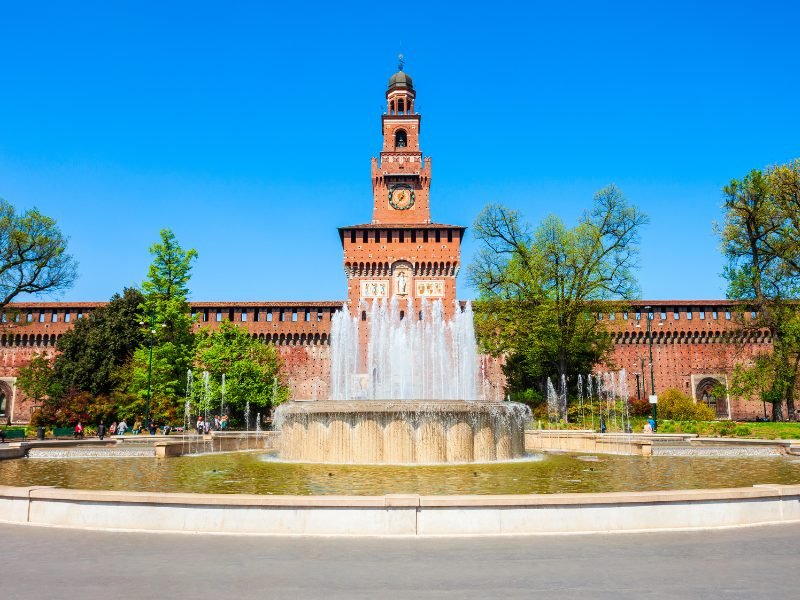
Castello Sforzesco (also known as Sforza Castle) is a 15th-century castle in the center of Milan.
The castle was built by Francesco Sforza in 1450 on the remains of the 14th-century fortification, once the residence of the Visconti noble family.
Nowadays, Castello Sforzesco is one of the most important museum complexes in Milan.
Inside, you can visit the Pinacoteca with important paintings by Italian artists, the Museum of Ancient Art, the Egyptian Museum, and the Museum of Musical Instruments, to mention a few.
The best thing is that one entry ticket (you can book online here) will give you access to all the museums, so you can easily spend a day here!
Pinacoteca di Brera
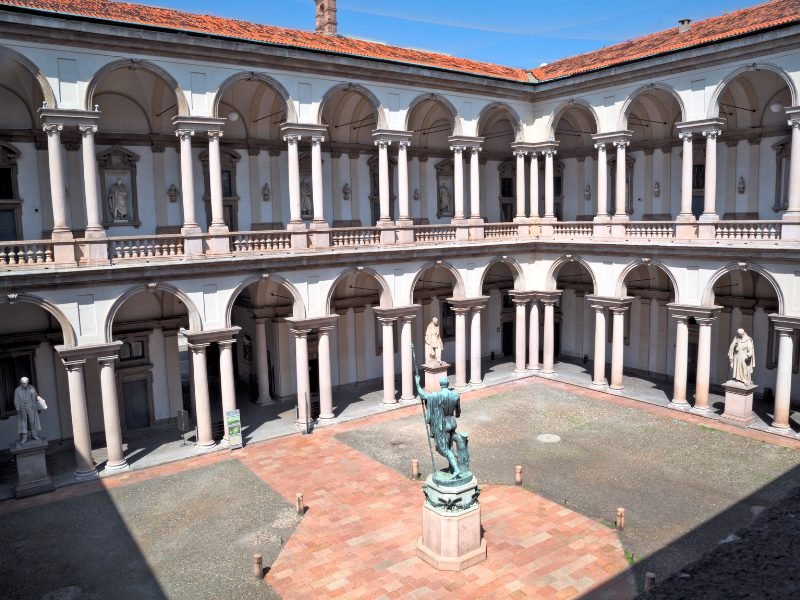
If there is only one art gallery you can visit in Milan, it should be Pinacoteca di Brera!
This stunning gallery houses a vast art collection from all over the world, with a focus on Northern Italian painters.
Among the masterpieces you can admire in the Pinacoteca, there’s The Kiss by Francesco Hayez, The Marriage of the Virgin by Raphael, and The Pietà by Giovanni Bellini.
You’ll also see works by Caravaggio, Modigliani, and Leonardo da Vinci, to mention a few other artists you may have heard of!
No wonder this is one of the top Milan attractions to visit on your next Milan itinerary.
Santa Maria delle Grazie & The Last Supper
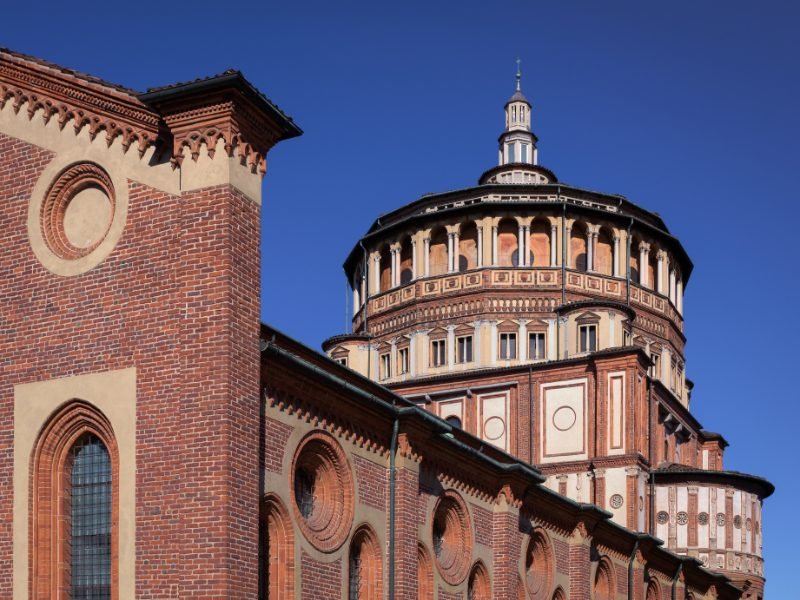
The Church of Santa Maria delle Grazie is better known for housing one of the most famous paintings ever created, Leonardo da Vinci’s the Last Supper.
The church is a great example of Renaissance art and a UNESCO World Heritage Site that you can visit for free (though to see The Last Supper, you must pay an additional fee).
However, the building is often overlooked in favor of the museum that houses the famous painting.
To admire The Last Supper, you must book a tour ticket online in advance.
Even during the low season, tickets sell fast, so booking online should be the first thing on your list.
Also, make sure to follow all instructions — time slots are booked and limited, so come accordingly!
Teatro alla Scala (La Scala Opera House)
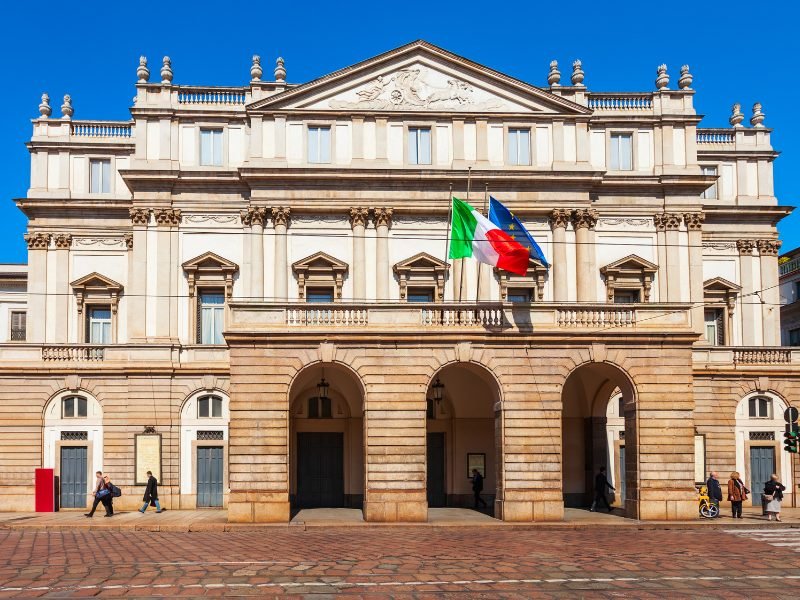
Teatro alla Scala is one of the most important opera houses in Italy and among the most prestigious in the world.
The theater dates to the late 18th century and saw the debut of several important composers, including Giuseppe Verdi and Giacomo Puccini.
The theater is open for visits and offers guided tours as well, including tours of the museum.
However, the best way to experience this amazing place is to attend a ballet or opera show!
Don’t worry if you don’t have deep pockets — culture in Milan can be quite cheap! Tickets start as low as 10€ for a show.
Museo del Novecento
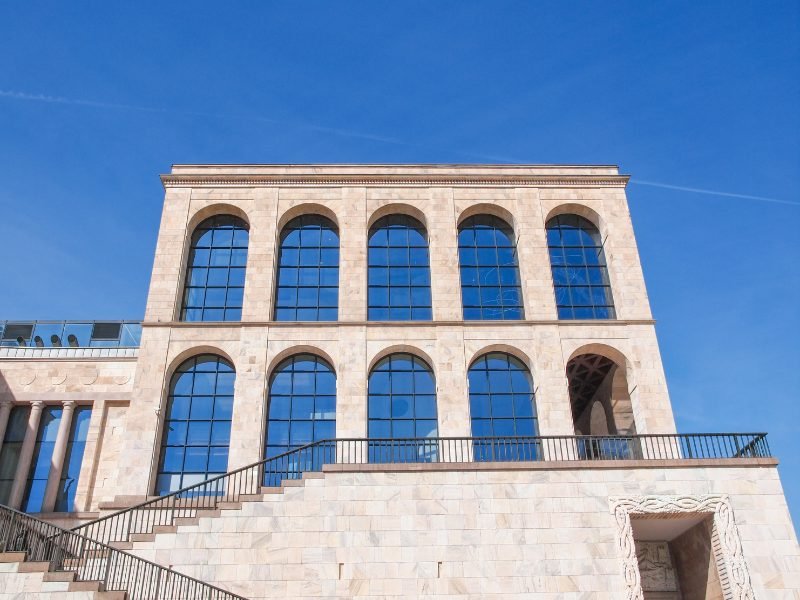
Located in a corner of Piazza del Duomo, Museo del Novecento houses a 20th-century art collection of international works.
Their collection includes important works by Kandinskij, Modigliani, de Chirico, Picasso, and Mondrian. Overall, the museum boasts a collection of over 300 artworks!
Given its location, the museum also offers stunning views of the Milan Duomo!
You may also find temporary exhibitions here, as well as special events such as concerts, talks, and screenings.
You can visit the museum on your own or book a guided visit.
Galleria Vittorio Emanuele II
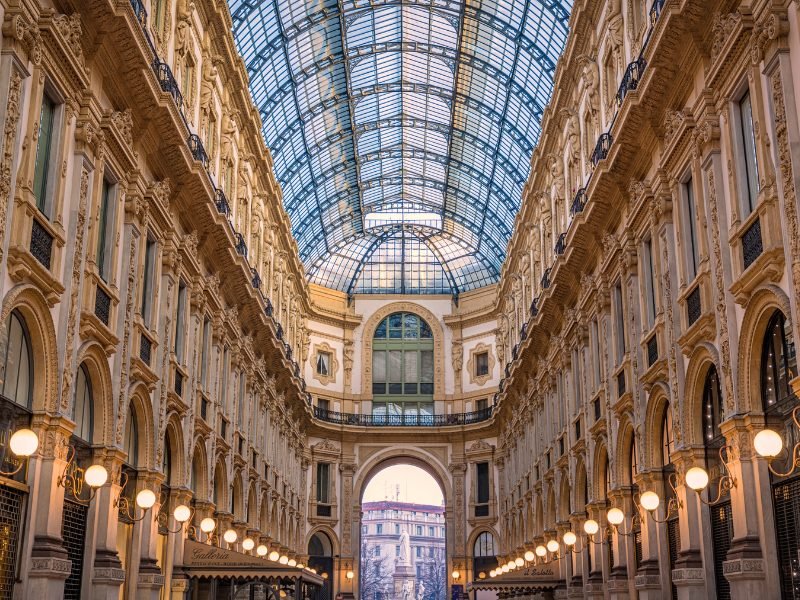
Galleria Vittorio Emanuele may be a shopping gallery, but it’s like no shopping mall you’ve ever seen. While it has some great shops, that is not the only reason to visit it!
The magnificent gallery built in the 19th century boasts an impressive glass dome and beautiful mosaics on the floor.
If you come across people spinning on their heels in the gallery, it’s all part of a good luck ritual!
There’s a bull depicted on the floor, recognizable from the hole where his testicles are supposed to be.
That’s where you should place your right heel to spin three times — a strange but true fact of this Milan landmark!
Aside from window shopping and performing the good luck ritual, you can also have lunch at one of the restaurants in the gallery or have a coffee break.
Basilica di Sant’Ambrogio
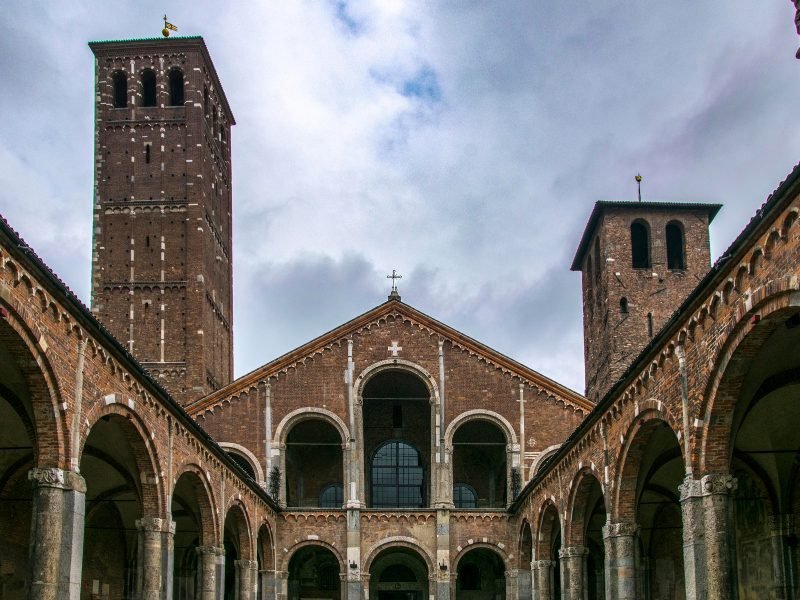
Basilica di Sant’Ambrogio is one of the oldest churches in Milan, built at the end of the 4th century by St. Ambrose.
Initially called Basilica Martyrum, the church underwent many restorations before its completion at the end of the 11th century in the Romanesque style. The crypt under the basilica houses the tomb of St. Ambrose.
One of the highlights inside the church is the ceiling of the Oratory of San Vittore in Ciel d’Oro, with a portrait of St. Ambrose on the gilded dome.
Outside the church, you can see a column with two small holes in it, known as the Devil’s Column.
According to the legend, the holes were made by the devil when he hit the column after not managing to induce St. Ambrose into temptation.
Arco della Pace
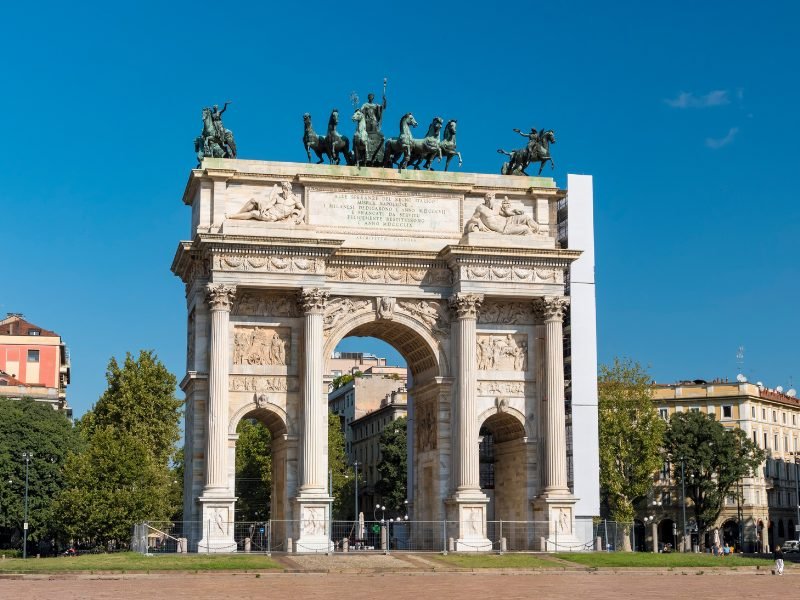
The imposing triumphal arch at the beginning of Corso Sempione is one of the most salient Neoclassical landmarks in Milan.
The Arch of Peace wanted by Napoleon was built at the beginning of the 19th century in the place of an ancient Roman city gate called Jupiter’s Gate.
The gate is decorated with bas-reliefs depicting key moments in Italy’s and Europe’s history, including the founding of the Lombardo-Venetian Kingdom and the Congress of Vienna.
The arch also contains references to classical mythology subjects, including the sculpture of Minerva driving the horse-pulled chariot on its top.
Branca Tower
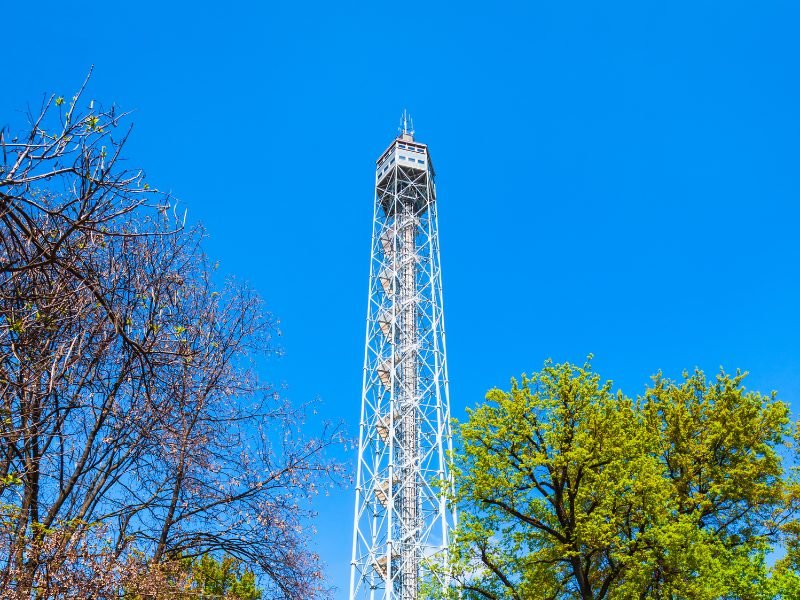
If you want to enjoy a stunning panoramic view of Milan, climb to the top of Branca Tower.
The iron tower was built during the fascist period in 1933 and was originally named Torre Littoria.
The name was later changed to Torre del Parco, given its location in Parco Sempione.
The current name of the tower comes from the liquor company Branca, which restored it in 2002.
While it may not be a particularly beautiful sight, the tower is one of the tallest structures in Milan and allows you to see the entire city and even the Alps and Apennines on clear days!
Cimitero Monumentale (Monumental Cemetery)
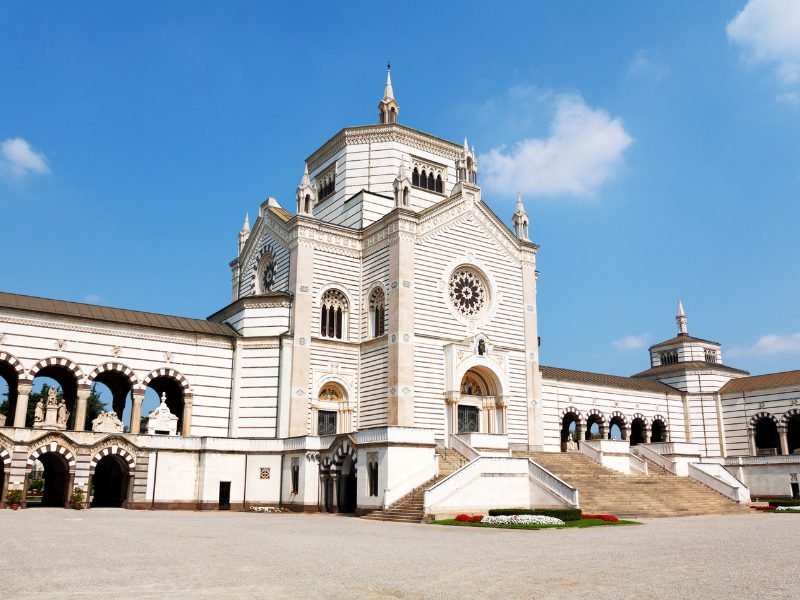
The Monumental Cemetery in Milan is famous for the beautifully decorated tombs and the many monuments in different styles, including classical and contemporary sculptures, Greek temples, obelisks, and more.
Many notable personalities rest in this cemetery, including artists, politicians, and scientists.
A few of the most notable figures are painter Francesco Hayez, drink maker Gaspare Campari, writers Alessandro Manzoni, Alda Merini, and Filippo Tommaso Marinetti, and fashion designer Franco Moschino.
Some of the most beautiful monuments are The Last Supper sculpture on the Campari family tomb, the mausoleum of Antonio Bernocchi, and the Morgagni family monument.
Museo Nazionale della Scienza e della Tecnologia Leonardo da Vinci
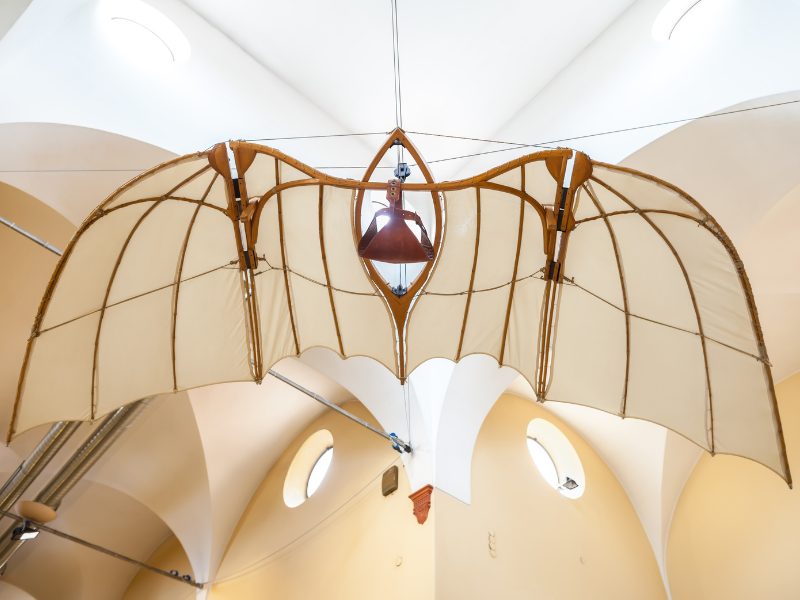
Housed in a former monastery, this science museum is a great place to visit if you’re interested in science.
The museum houses an impressive collection of 18,000 objects, including ships and submarines, airplanes, early computers, inventions and creations by Leonardo da Vinci, and even a moon rock.
You can visit the museum any day except for Mondays.
You can buy your tickets online but, unlike other more famous museums, you’ll have no trouble finding available spots for the following day.
Royal Palace

The Royal Palace of Milan used to be the seat of the government in the city. Nowadays, this imposing palace is an art museum housing a permanent collection and temporary exhibitions.
The Neoclassical palace is located in Piazza del Duomo and was originally built during the Middle Ages, then was renovated during the 16th century.
Milan’s Royal Palace was heavily damaged in 1943 when British forces bombarded the city. After the shelling, a fire destroyed many areas of the palace, including the famous Hall of Caryatids.
In 1953, the palace hosted an exhibition by Picasso, with the masterpiece Guernica — now back in the Reina Sofia, a famous Madrid landmark — being the main feature.
Only at the beginning of the 2000s did the Royal Palace become a museum!
Recently, it hosted many exhibitions dedicated to Claude Monet, Pablo Picasso, and other prominent artists.
Check what’s on during your visit and book your ticket online.
Palazzo Morando
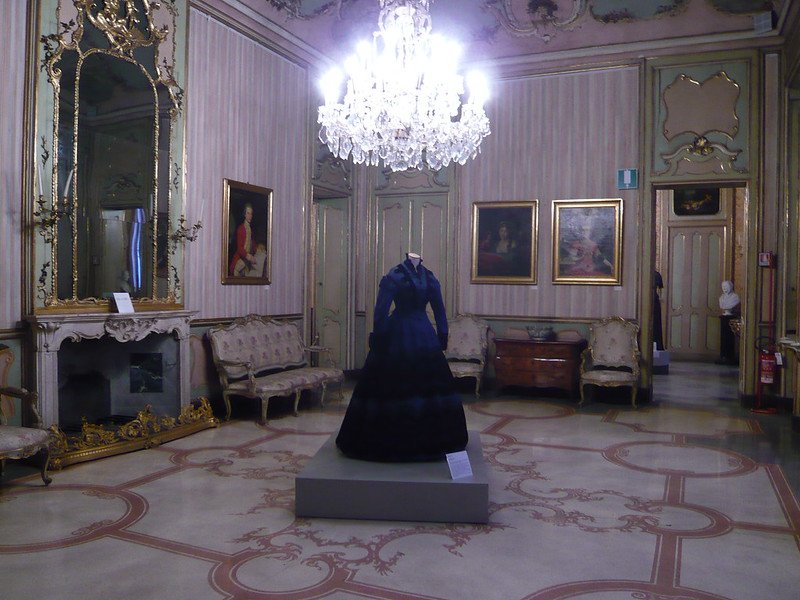
When in the capital of fashion, you should visit a museum dedicated to fashion, of course!
Palazzo Morando is a Neoclassical building in the historical center of Milan that once belonged to a noble Milanese family.
The building houses a permanent exhibition that includes antique furniture and costumes from the 17th to the 20th centuries and a collection of paintings and sculptures from the same period.
The museum also organizes temporary exhibitions, often dedicated to fashion, but not exclusively!
Basilica San Lorenzo Maggiore
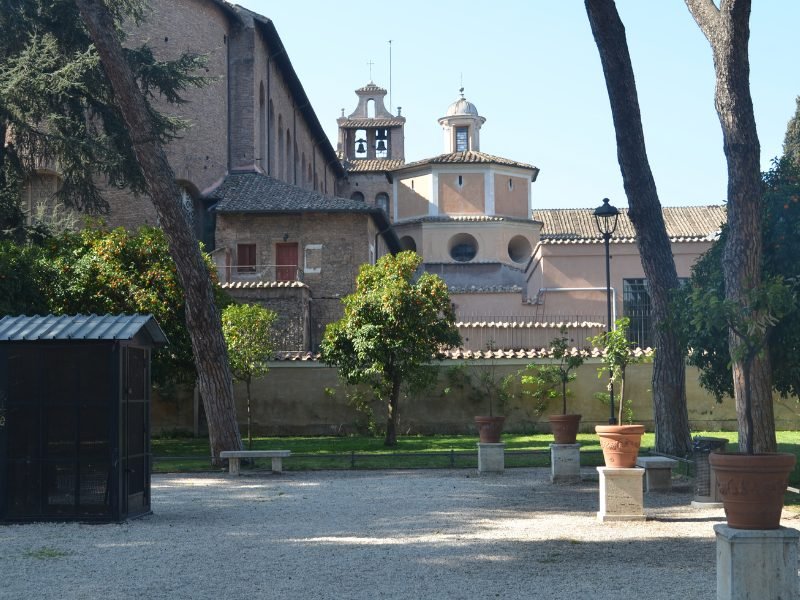
Of the many churches in Milan, Basilica San Lorenzo Maggiore is one of the oldest and most impressive.
Initially built at the end of the 4th century CE, the basilica was the largest one at the time. In 590, the basilica was dedicated to St. Lawrence.
The church was renovated many times due to the several disasters that damaged it, including fires and earthquakes.
Nevertheless, the basilica maintains parts of the original building, including the mosaic of Christ the Lawgiver in the Chapel of St. Aquilino.
You can visit the basilica for free, but you must pay a small fee to enter the Chapel of St. Aquilino — worth it if you want to see the mosaics!
Columns of St. Lawrence
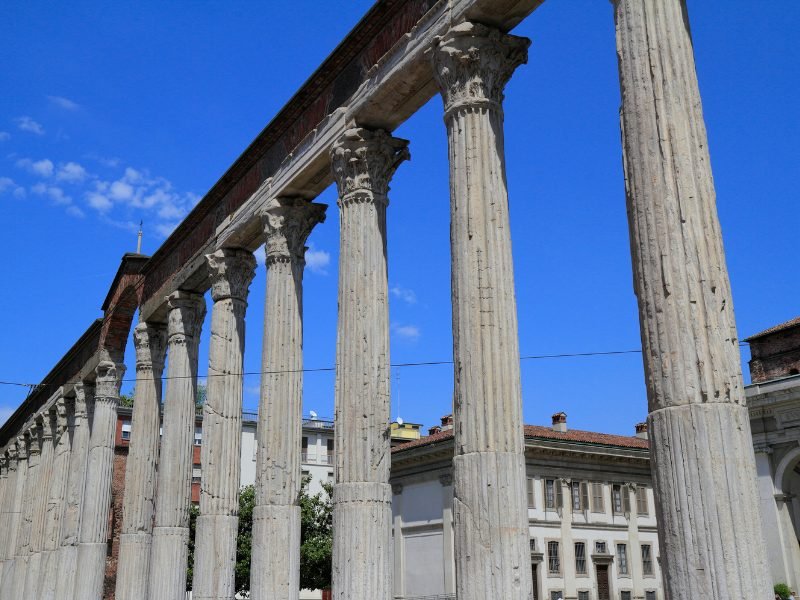
Outside the Basilica San Lorenzo Maggiore, the columns dedicated to the saint are even more ancient than the church itself!
It is believed that the columns were part of a 2nd-century pagan temple or a public bath and were moved to their current location in the 4th century. The 16 columns are among the few surviving remains of the Imperial era in Milan.
The columns of St. Lawrence are right in front of the basilica, creating a vast square in the middle. However, this was not always the case!
The space between the columns and the church was once filled with houses, which were removed in 1935.
Chiesa di San Maurizio al Monastero Maggiore
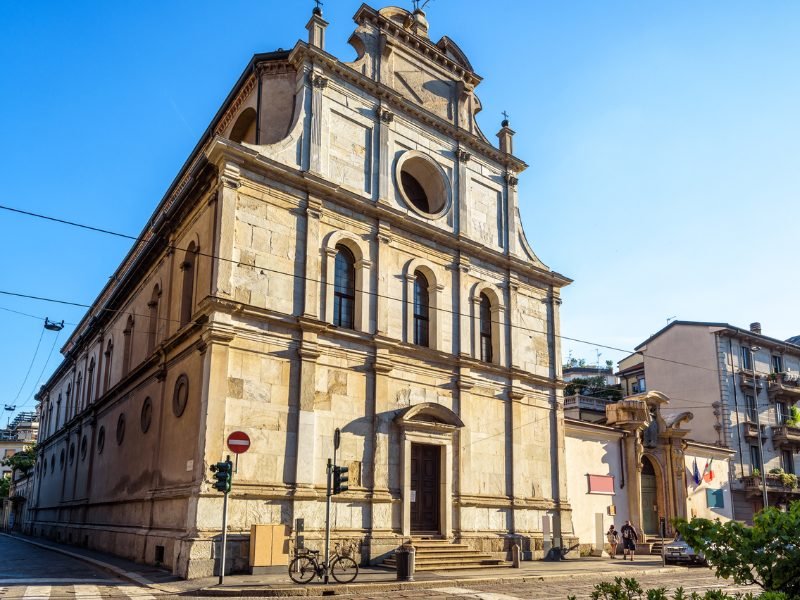
The Church of Saint Maurice is another important church in Milan, originally attached to a convent of the Benedictines called Monastero Maggiore.
The church was built at the beginning of the 16th century and combines Renaissance and Baroque styles.
The main features of the church are the frescoes on the walls, depicting various scenes, including the Life of Saint Maurice and Adoration of the Magi.
The Hall of the Nuns is also entirely decorated with images of various saints and Christ carrying the cross.
The church is not such a popular landmark in Milan, so you can admire the beautiful works of art without crowds. Plus, entrance is free!
Santuario di San Bernardino alle Ossa
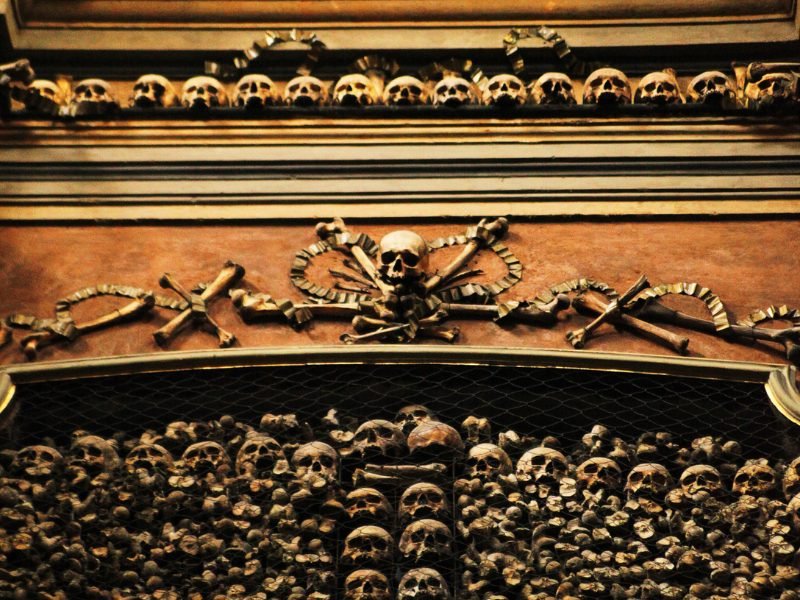
The church of San Bernardino is mainly famous for housing an impressive ossuary, hence the name of San Bernardino alle Ossa.
On the site of the current church, there used to be a cemetery, back in the 12th century. When the space in the cemetery proved insufficient, a room aboveground was built to hold the exhumed bones.
The first church was built in the 13th century but only lasted until the 17th century, when it was destroyed and replaced by the current church. The ossuary was rebuilt and decorated in 1695.
The small chapel covered in skulls and bones is an impressive sight you shouldn’t miss in Milan!
There is no charge to visit the church and ossuary, but you can leave a donation.
Piazza Mercanti
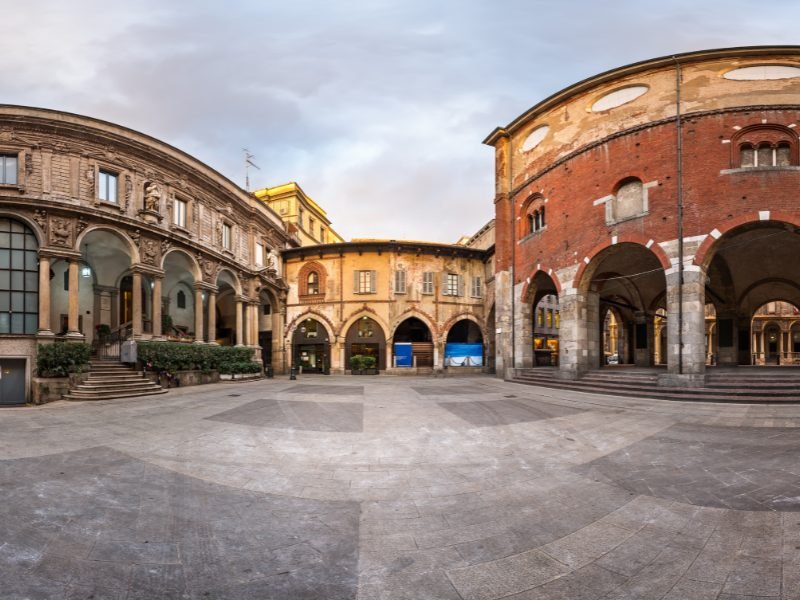
As the name suggests, Piazza Mercanti (translated as The Merchants’ Square) was the city’s commercial center during the Middle Ages.
The square is one of the few areas in Milan that still maintains the charming Medieval look, making it a unique Milan landmark.
Around the square, you can see several important Medieval buildings, including the Palazzo della Ragione with its beautiful arcades, the Loggia degli Osii, the Gothic-style Casa dei Panigarola, and Palazzo delle Scuole Palatine, once the main higher-education school in Milan.
Navigli
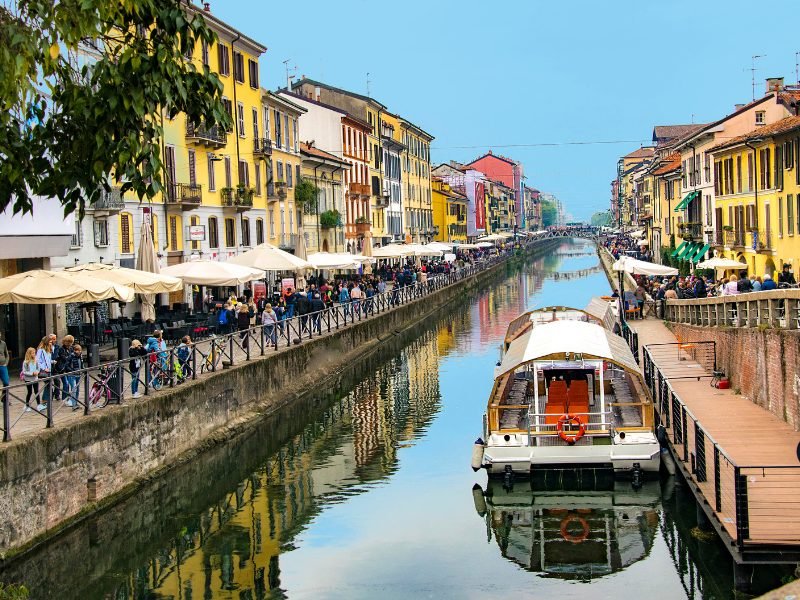
Though not exactly a landmark in the traditional sense, the Navigli area in Milan is a popular spot for nightlife and one of the most picturesque areas in Milan!
It’s also a popular area to stay in Milan for young people, as the vibe at night is excellent.
Navigli means canals, and the name comes from the two artificial canals flowing here, Naviglio Grande and Naviglio Pavese.
The canals are lined with restaurants, bars, and clubs. The area livens up from the late afternoon when locals head to the Navigli for their daily aperitivo!
The streets between the canals house artisan shops, art galleries, and local markets, including a monthly antique market.
During the Christmas holidays, the area lights up with Christmas lights and decorations, making it a great place to visit if you’re coming to Milan in winter.
Mudec
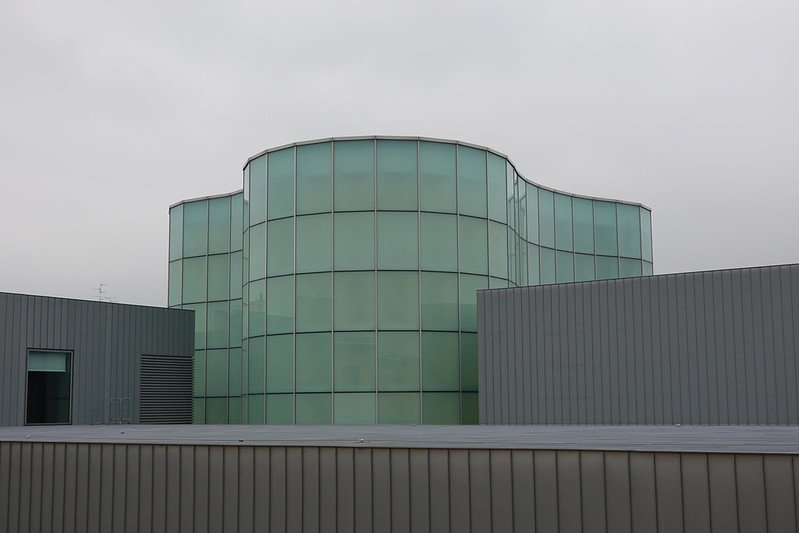
Museo delle Culture, or Mudec, is an impressive new museum dedicated to art and culture housed in a former factory.
The museum only opened in 2015 and is one of the most recent additions to Milan’s cultural life, but already an important one.
The museum hosted remarkable exhibitions dedicated to some of the greatest artists, including Gauguin, Joan Miró, Kandinskij, Klimt, Frida Kahlo, Modigliani, Steve McCurry, Henri Cartier-Bresson, Marc Chagall, and David Lachapelle.
Exhibitions can last between two and five months, so make sure you check what’s on before your trip.
Piazza degli Affari & L.O.V.E Sculpture
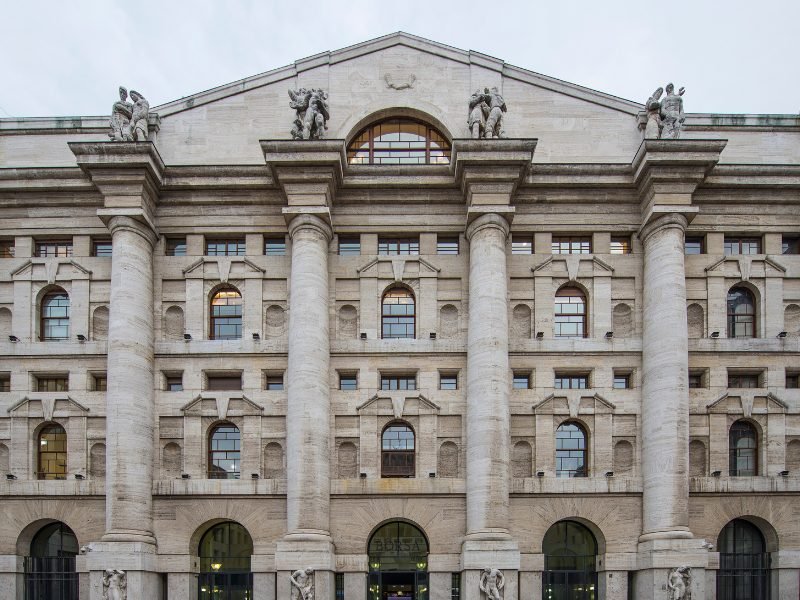
At the heart of the financial district of Milan, Piazza Affari is the location of the Italian Stock Exchange.
However, the most captivating feature is not the square itself nor the impressive 20th-century building of the Stock Exchange, but the sculpture right in front of it.
In 2010, artist Maurizio Cattelan placed a gigantic middle finger in the square. The provocative sculpture in Carrara marble is called L.O.V.E.
The acronym stands for “libertà, odio, vendetta, eternità”, which translates to “freedom, hate, revenge, eternity”.
According to the artist, the sculpture represents a hand engaged in the Fascist salute with all fingers except the middle one eroded by time.
Triennale di Milano
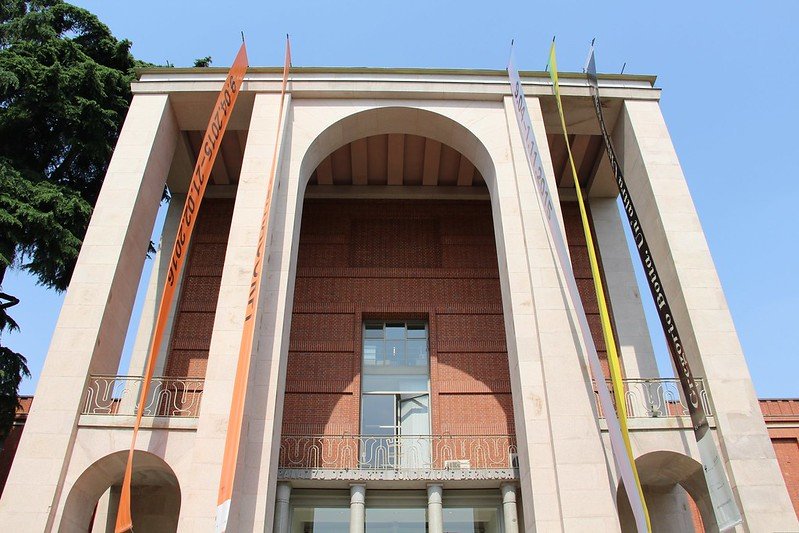
Located in Parco Sempione, the Triennale di Milano is an exhibition center dedicated to architecture, design, visual arts, and performing arts.
The space houses a variety of cultural and artistic events, from shorter events dedicated to anything from TV shows to photography, to longer art exhibitions.
If you’re looking for unique and unusual events while in Milan, check what’s on at the Triennale!
You may find cool festivals, DJ sets, fascinating exhibitions, performances, dance shows, concerts, and more.
Piazza Gae Aulenti
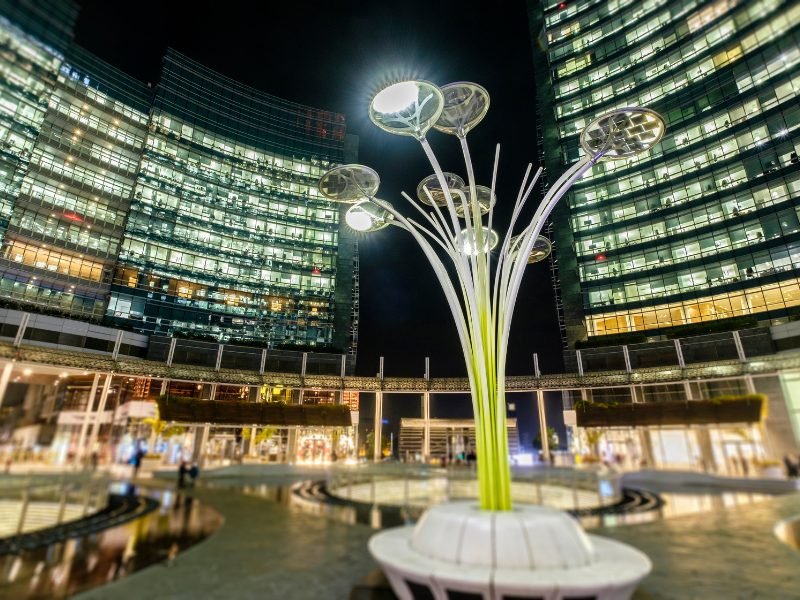
Located in the most modern area of Milan, close to Porta Garibaldi, Piazza Gae Aulenti is a square surrounded by tall skyscrapers and featuring beautiful modern fountains that light up at night.
The square is dedicated to female architect Gae Aulenti, better known for designing the Musée d’Orsay in Paris, and was inaugurated in 2012 shortly after her death.
The square is often the location of events and local fairs, especially during the Christmas holidays and Milan Fashion Week.
Bosco Verticale
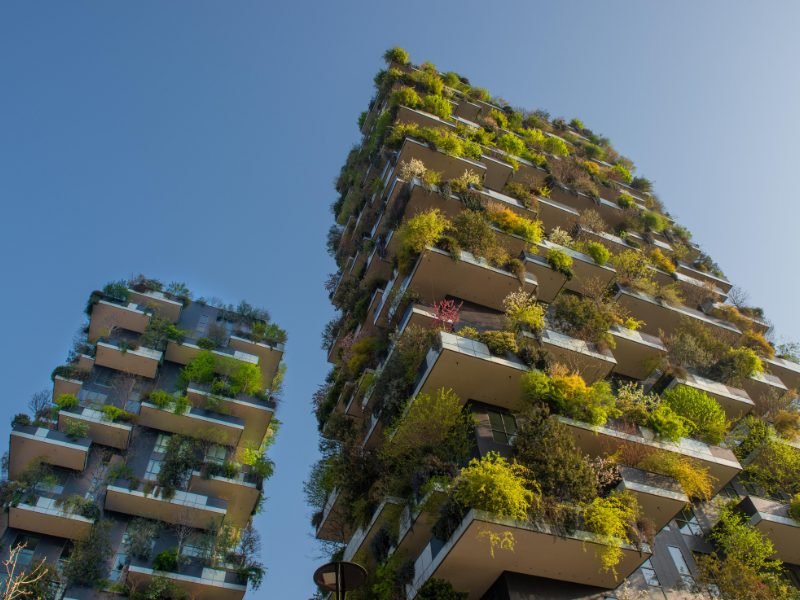
At the edge of the Parco Biblioteca degli Alberi with its beautiful landscape design, Bosco Verticale is a set of two residential towers covered in trees and shrubs.
The name of the buildings, which became a symbol of green urban design, translates to The Vertical Forest.
If you’re looking to see a more futuristic side of Milan, go for a walk in the nearby park and admire this interesting architectural feat designed by Stefano Boeri.
Where to Stay in Milan
Downtown Milan
A great option in downtown Milan is Antica Locanda Dei Mercanti, a quaint guest house located in an elegant 18th-century building with a terrace offering great views of downtown.
Brera
For a more quiet part of Milan than the center, San Marco Boutique Apartments features spacious studios in the Brera district with modern kitchenettes and A/C.
Porta Romana
For a slice of local life in Milan, La Casa Colorata features beautiful modern units — with access to two saunas in the common relaxing area!
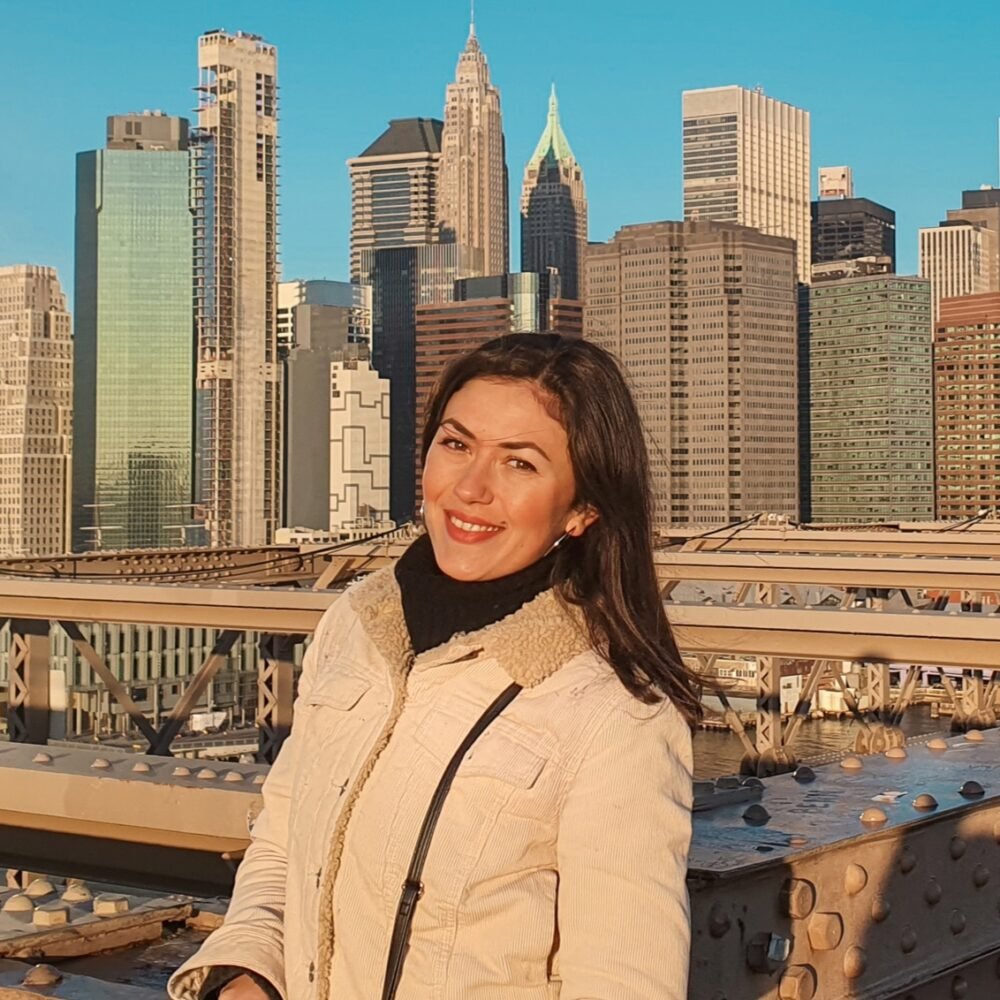
Roxana is a Romanian-born freelance travel writer who has lived in Italy for over 15 years. She has a Master’s in Journalism and a Bachelor’s in Film Studies, and she studied at Università degli Studi di Roma Tre. Besides her native Romania, Roxana has lived in Rome, Lisbon, and Berlin, and she has traveled through much of Europe in search of hidden gems, history, and culture.